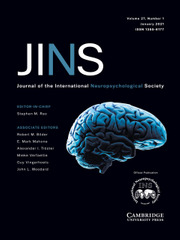Regular Research
The Neurological Predictor Scale Predicts Adaptive Functioning via Executive Dysfunction in Young Adult Survivors of Childhood Brain Tumor
-
- Published online by Cambridge University Press:
- 09 July 2020, pp. 1-11
-
- Article
- Export citation
Adaptive Plasticity Under Adverse Listening Conditions is Disrupted in Developmental Dyslexia
-
- Published online by Cambridge University Press:
- 07 August 2020, pp. 12-22
-
- Article
-
- You have access
- Open access
- HTML
- Export citation
Test–Retest Reliability of Concussion Baseline Assessments in United States Service Academy Cadets: A Report from the National Collegiate Athletic Association (NCAA)–Department of Defense (DoD) CARE Consortium
-
- Published online by Cambridge University Press:
- 16 June 2020, pp. 23-34
-
- Article
- Export citation
Sleep Deprived or Concussed? The Acute Impact of Self-Reported Insufficient Sleep in College Athletes
-
- Published online by Cambridge University Press:
- 09 July 2020, pp. 35-46
-
- Article
- Export citation
Association Between Visual Memory and In Vivo Amyloid and Tau Pathology in Preclinical Autosomal Dominant Alzheimer’s Disease
-
- Published online by Cambridge University Press:
- 07 August 2020, pp. 47-55
-
- Article
- Export citation
Interaction between Alcohol Consumption and Apolipoprotein E (ApoE) Genotype with Cognition in Middle-Aged Men
-
- Published online by Cambridge University Press:
- 14 July 2020, pp. 56-68
-
- Article
- Export citation
Positive Psychosocial Factors and Cognitive Decline in Ethnically Diverse Older Adults
-
- Published online by Cambridge University Press:
- 25 August 2020, pp. 69-78
-
- Article
- Export citation
The Art of Remediating Age-Related Cognitive Decline: Art Therapy Enhances Cognition and Increases Cortical Thickness in Mild Cognitive Impairment
-
- Published online by Cambridge University Press:
- 07 August 2020, pp. 79-88
-
- Article
-
- You have access
- Open access
- HTML
- Export citation
Episodic Memory and Verbal Fluency Tasks: Normative Data from Nine Nationally Representative Samples
-
- Published online by Cambridge University Press:
- 07 August 2020, pp. 89-98
-
- Article
- Export citation
Case Report
Brain Reserve in a Case of Cognitive Resilience to Severe Leukoaraiosis
-
- Published online by Cambridge University Press:
- 16 June 2020, pp. 99-108
-
- Article
- Export citation
Other
Acknowledgements to JINS Guest Editors and External Reviewers, 2020
-
- Published online by Cambridge University Press:
- 27 January 2021, pp. 109-112
-
- Article
- Export citation
Front Cover (OFC, IFC) and matter
INS volume 27 issue 1 Cover and Front matter
-
- Published online by Cambridge University Press:
- 27 January 2021, pp. f1-f2
-
- Article
-
- You have access
- Export citation
Back Cover (OBC, IBC) and matter
INS volume 27 issue 1 Cover and Back matter
-
- Published online by Cambridge University Press:
- 27 January 2021, pp. b1-b5
-
- Article
-
- You have access
- Export citation

